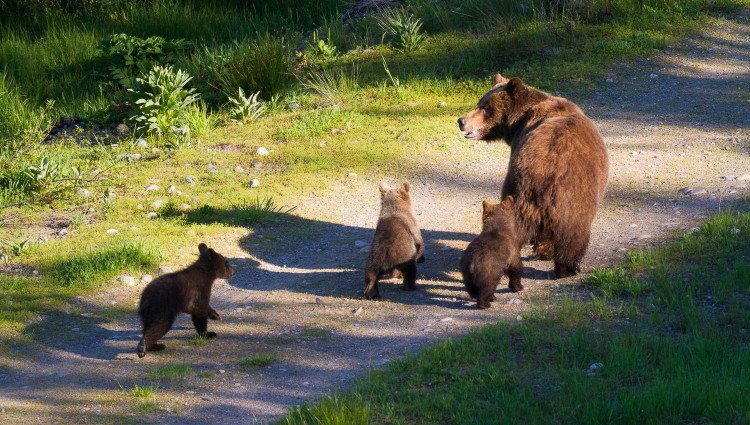
Pique, A bear on the land by Leslie Anthony-
In the early hours of 11 July, 2014, a month after being fitted with a GPS collar that recorded her position every two hours, a young female grizzly bear tagged F148 lay down on the outskirts of the Banff townsite for a few hours’ rest.
Earlier F148 had spent time foraging grasses and protein-rich (wildflowers) near horse corrals at the town’s main ingress from the Trans-Canada Highway. Observed here often by both park staff and the public, she was tolerant enough of humans to be permitted these gustatory pursuits. And now, said her collar, she was sleeping even closer to human facilities — not for the first or last time in a pattern that those tracking her had come to understand in a novel context: as a security measure.
The penchant for bedding down near buildings, roadways and other infrastructure is one of the more recent pieces in the puzzle of grizzly biology and behaviour revealed over some 30 years of tagging studies in Alberta’s Bow River corridor. It’s also emblematic of the double-edged sword that coexistence with grizzlies represents: just as bears are part of life for the people of Banff, humans are part of life for F148, who has never known different. With bears as adept as humans at identifying and exploiting opportunities and benefits in our shared environment, where do we draw the line between co-dependence and conservation?
It’s a question that Steve Michel, Human/Wildlife Conflict Specialist at Parks Canada in Banff, is intimately familiar with. With campgrounds, trails, golf courses, railroads, highways and even backyard fruit trees under his aegis, Michel is charged with ascertaining when a bear can legitimately remain where it is and when it might need persuasion — or genuine aversion — to move along. The information and lessons required to make such decisions don’t all come as easily as the data being beamed to headquarters from F148.
In a 2013 TEDx talk in nearby Canmore on “Living with Wildlife,” Michel confesses to an affair with a good-looking female in her mid-20s, joking that although he doesn’t know her name, he can always “track her down — because I’ve got her number.” In typical small-town fashion, the audience was already aware of this dalliance, laughing at the obvious reference to Banff’s most famous grizzly, F64 — coincidentally F148’s mother.
Years before, on a popular trail, Michel had encountered F64 in “a worst-case scenario” — surprising her as she fed on an elk carcass with her cubs, furthering the provocation by making eye contact at close range. But after a few frozen seconds, the bear simply looked back down and continued eating. Heart in throat, Michel backed away. In his talk, Michel shares the conclusion he reached after reflecting on such experiences and the wealth of data from ongoing studies in places like Banff and Lake Louise: “One of (our) big insights… is that grizzly bears often like to come close to us; they do that on purpose and they do it for their own safety… And you might be thinking, well, what does a grizzly bear have to fear?… the reality is they have to fear other, bigger grizzly bears; so for young (grizzlies) or particularly females with cubs, if they come close to human facilities… they can keep their cubs safe… We can all relate to this idea: Who wouldn’t want to keep your kids safe? And I think if we understand why they’re doing that we can go a long way to putting fear aside and replacing it with respect.”
Read the full article here.
